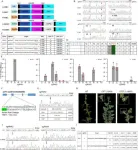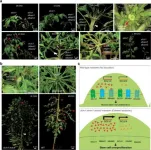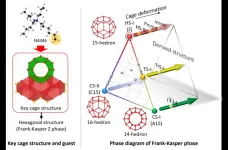(Press-News.org) The results of routine blood tests could be used to speed up cancer diagnosis among people with stomach pain or bloating, suggests a new study led by UCL researchers.
Most people who report these symptoms to their GP are referred for blood tests. However, it is not known how well these blood tests, used to explore a range of possible causes of ill health, can predict cancer risk.
The new study, published in PLOS Medicine, looked at data from more than 400,000 people aged 30 or older in the UK who had visited a GP due to stomach pain and more than 50,000 who had visited their GP due to bloating. Two thirds of this group had blood tests following their appointment.
The researchers found that, in 19 commonly used blood tests, abnormal results were linked to a higher risk of being diagnosed with cancer within a year. They estimated that, if these abnormal results were taken into account, there would have been a 16% increase in the number of people with undiagnosed cancer who were given an urgent referral, compared to assessment based on symptoms, age and sex alone.
This translates as an extra six people with undiagnosed cancer being urgently referred out of 1,000 people who had visited the GP with stomach pain or bloating, on top of 40 people with cancer being urgently referred already, without using blood test results.*
Lead author Dr Meena Rafiq, of the UCL Department of Behavioural Science & Health, said: “Our study suggests we can improve cancer detection with blood tests that are already available and that are routinely given to patients with non-specific symptoms whose cause is unclear. This could be an efficient, affordable way to improve early cancer diagnosis and in some cases increase the likelihood of successful treatment.
“Given that in practice it may be challenging for GPs to interpret a range of blood test data, our study points to the need for an automated tool that could assess cancer risk based on multiple variables.”
The study used anonymised patient data from the Clinical Practice Research Datalink (CPRD), collected from a network of GP practices across the UK between 2007 and 2016.
The researchers found that one in 50 (2.2%) people who went to the GP reporting stomach pain were diagnosed with cancer over the next 12 months. Precisely the same proportion (2.2%) of people reporting bloating were also diagnosed with cancer within a year.
In the UK, guidelines from the National Institute for Health and Care Excellence (NICE) say that people should be given an urgent cancer referral (i.e. referred to a specialist or for tests) if their risk of cancer is higher than 3%.
In the new study, the researchers found that people aged 60 or over who had gone to the GP with either stomach pain or bloating had a high enough risk to warrant an urgent cancer referral (that is, their risk was higher than 3%) regardless of blood test results. Currently, over-60s with stomach pain or bloating are only given a cancer referral in the UK if they have an additional potential cancer signal such as weight loss.
Risk of cancer was estimated to be 3.1% for men in their 60s reporting stomach pain, rising to 8.6% for men in their 80s with this symptom. For women in these age groups, the risk was 3.1%, rising to 6.1%.
The researchers cautioned that the incidence of cancer was likely to be higher in the study sample than among a broader group of people experiencing stomach pain or bloating who would not necessarily go to their GP or have blood tests.
In the UK study sample, the researchers found that, among people aged 30 to 59 years with abdominal pain or bloating, anaemia, low albumin, raised platelets, abnormal ferritin, and increased inflammatory markers strongly predicted a risk of undiagnosed cancer.
For example, in women aged 50 to 59 with abdominal bloating, pre-blood test cancer risk of 1.6% increased to 10% with raised ferritin, to 9% with low albumin, to 8% with raised platelets, to 6% with raised inflammatory markers and to 4% with anaemia.
Currently, only raised platelets and anaemia are included in guidelines for cancer referral. The guidelines, the researchers noted, focused on the presence of ‘alarm’ symptoms and risk of cancer of a single organ, with limited guidance existing for vague symptoms that could be a sign of cancer in a number of different organs.
Dr Rafiq added: “Half of all people with as-yet-undetected cancer will first go to the doctor with vague symptoms that can be challenging to diagnose. Many of these patients are investigated in primary care with commonly used blood tests that could help to identify which patients are most likely to have underlying cancer and should be prioritised for referral.
“This research shows these common tests can substantially enhance assessment of cancer risk.”
The study also showed which types of cancer were most common for people with these symptoms and how this varied depending on age and sex. Overall, bowel cancer was most common, followed by prostate and pancreatic cancer in men, while in women bowel cancer was followed by breast and ovarian cancer.
The researchers said the findings on the predictive value of blood tests for cancer could not be extrapolated to other health systems with higher or lower rates of blood test use.
The study was funded by the International Alliance for Cancer Early Detection (ACED), a partnership between UCL, Cancer Research UK (CRUK), Canary Center at Stanford University, the University of Cambridge, OHSU Knight Cancer Institute, and the University of Manchester. Additional funding came from CRUK and the National Institute of Health Research (NIHR).
* If any patient had one or more than one blood test that increased their risk to above 3% (and they would not have been referred based on their age, sex and symptom alone) they were included as an extra urgent referral.
END
Common blood tests could improve cancer diagnosis for people with stomach pain or bloating
The results of routine blood tests could be used to speed up cancer diagnosis among people with stomach pain or bloating, suggests a new study led by UCL researchers
2024-07-30
ELSE PRESS RELEASES FROM THIS DATE:
Is that glass bottle of OJ better for the planet than a plastic container?
2024-07-30
Which packaging type for a 12-ounce, single-serve container of orange juice would you choose as the most sustainable option:
Aluminum/canned, made with recycled material;
Carton, described as biodegradable/compostable;
Glass, 100% recyclable; or
Plastic, described as biodegradable/compostable?
If you were like the U.S. consumers surveyed by food scientists in a University of Massachusetts Amherst study, you’d prefer glass and believe it was the most sustainable choice. And you all would be mistaken.
“Glass was ...
Hydrogen-rich gas inhalation can alleviate exercise-induced fatigue
2024-07-30
A new study published in the International Journal of Sports Medicine, Inhalation of hydrogen-rich gas before acute exercise alleviates exercise fatigue, has found a possible novel intervention for exercise-induced fatigue. A cross-discipline international team of U.S. and Chinese researchers, including at Hebrew SeniorLife’s Hinda and Arthur Marcus Institute for Aging Research, found that inhaling hydrogen-rich gas (HRG) before engaging in acute exercise can significantly reduce fatigue and enhance performance.
The research involved 24 healthy adult men who were tested for their maximum cycling ...
Fruitful innovation: Transforming watermelon genetics with advanced base editors
2024-07-30
The development of new adenine base editors (ABE) and adenine-to-thymine/guanine base editors (AKBE) is transforming watermelon genetic engineering. These innovative tools enable precise A:T-to-G and A:T-to-T base substitutions, allowing for targeted genetic modifications. The research highlights the efficiency of these editors in generating specific mutations, such as a flowerless phenotype in ClFT (Y84H) mutant plants. This advancement not only enhances the understanding of gene function but also significantly improves molecular breeding, paving the way for more efficient watermelon crop improvement.
Traditional breeding methods for watermelon ...
SwRI’s Dr. Sergey Vinogradov to receive Ward Rummel Engineering Excellence Award
2024-07-30
SAN ANTONIO — July 30, 2024 —SwRI’s Dr. Sergey Vinogradov has been named the recipient of the American Society for Nondestructive Testing (ASNT) Ward Rummel Engineering Excellence Award, which recognizes outstanding sustained contributions in nondestructive testing (NDT) by a single individual. NDT, also known as nondestructive evaluation (NDE), uses technology to evaluate and inspect materials and components for safety and reliability without damaging them.
“Dr. Vinogradov pioneered using magnetostrictive transducer technology in NDE applications, developing the original designs as well as producing countless custom ...
Stem cell harmony: How solanaceae plants maintain homeostasis through receptor compensation
2024-07-30
A pivotal study sheds light on the evolutionary conservation of stem cell homeostasis in Solanaceae, revealing how receptor compensation mechanisms ensure the continuous and orderly formation of plant organs. This research uncovers the genetic interplay that maintains stem cell balance, offering new perspectives for crop improvement and resilience enhancement.
Stem cell homeostasis is vital for the continuous formation of plant organs. This process involves intricate interactions among peptide ligands and their receptor-like kinases. Due to the dynamic nature of plant genomes, understanding ...
Illicit fentanyl use linked to increased risk of hepatitis C among people who use drugs
2024-07-30
An international team of researchers from University of California San Diego and el Colegio de la Frontera Norte in Mexico have revealed a significant association between the use of illicit fentanyl and the transmission of hepatitis C virus (HCV) among people who inject drugs in San Diego, California and Tijuana, Mexico. The findings, published in Clinical Infectious Diseases, suggest that illicit fentanyl use could be driving recent increases in HCV incidence.
"Our study provides the first evidence that illicit fentanyl ...
Elusive predicted water structure created in the laboratory
2024-07-30
Clathrate hydrates are complex water structures that contain foreign guest molecules inside a host water-molecule shell. A predicted clathrate hydrate phase structure has been stably synthesized in the lab and may play an important role in future material science research.
Water molecules are made up of just three atoms: two hydrogen atoms bound to a single oxygen atom. Individual water molecules can weakly bind to one another and other molecules, changing their collective physicochemical properties.
Clathrate hydrates, in particular, are lattices of water molecules that self-assemble ...
Algorithm helps doctors identify more aggressive types of basal cell carcinoma
2024-07-30
An algorithm can help healthcare professionals recognize which patients have a highly aggressive form of basal cell carcinoma (BCC) of the face. These are the findings of a study conducted at the University of Gothenburg. If more BCCs are correctly identified as high-risk, the patients can directly receive the most effective treatment.
BCC is the most common form of skin cancer. The cancer type grows slowly and almost never spreads to other parts of the body. Most of the BCCs all are cured, but without treatment, highly ...
Mental health problems often go undetected in youth who die by suicide
2024-07-30
Three out of five youth who died by suicide in the U.S. did not have a prior mental health diagnosis, signaling missed opportunities to identify children and adolescents for suicide prevention strategies, including therapy or medications to treat depression. This finding comes from an analysis of over 40,000 suicides by youth of 10-24 years of age from 2010 to 2021, recorded in the Centers for Disease Control and Prevention National Violent Death Reporting System. Results were published in the journal JAMA Network Open.
“We discovered that certain youth who died by suicide were less likely to have a documented ...
How spreading misinformation is like a nuclear reaction
2024-07-30
WASHINGTON, July 30, 2024 – It has never been easier to spread false or misleading information online. The anonymous, impersonal nature of the internet, combined with advanced tools like artificial intelligence, makes it trivial for bad actors to manipulate the truth and challenging for everyone else to separate reality from fiction. In this modern climate of disinformation, understanding how falsehoods and rumors spread is crucial for combating them.
In AIP Advances, by AIP Publishing, researchers from Shandong Normal University developed a new type of rumor propagation model, taking inspiration from nuclear reactions. Their model can provide fresh insights ...
LAST 30 PRESS RELEASES:
Itaconate modifications: mechanisms and applications
Potential tumor-suppressing gene identified in pancreatic cancer
Winners of the 2026 Hill Prizes announced
Autonomous AI agents developed to detect early signs of cognitive decline
Study finds ocean impacts nearly double economic cost of climate change
Increased deciduous tree dominance reduces wildfire carbon losses in boreal forests
Researchers discover how a respiratory bacterium obtains essential lipids from the human body and targets fat-rich tissues
Locust swarms destroy crops. Scientists found a way to stop that
More resources and collaboration needed to support prevention and treatment of obesity
Two types of underconfidence linked to anxiety and gender
Insects are victims too: Global study shows impacts of invasive alien species on populations
Pioneering natural, degradable polymer capsules
Forestry is becoming digital and automated
Maternity baby deaths much higher in northern England than in the South
Mosquitoes’ thirst for human blood has increased as biodiversity loss worsens
The stop-smoking medication varenicline may also work for cannabis use disorder
Potential new treatment for sepsis
Study reveals how many hours of video games per week might be too many
Electrospinning for mimicking bioelectric microenvironment in tissue regeneration
Home fingertip oxygen monitors less accurate for people with darker skin tones
Six weeks in a cast no less effective than surgery for unstable ankle fractures
Precautionary approach to alcohol-free and low alcohol drinks needed to protect public health, say experts
Gas-atomized Ca–Mg alloy powders produce hydrogen simply by adding water — high-efficiency hydrogen generation at room temperature
British redcoat’s lost memoir reveals harsh realities of life as a disabled veteran
World-leading rare earth magnet recycling facility launches in UK
Corday Selden selected for the Oceanography Society Early Career Award
MIT chemists determine the structure of the fuzzy coat that surrounds Tau proteins
Same moves, different terrain: How bacteria navigate complex environments without changing their playbook
Severe weather is deadly for vulnerable older adults long after the storm ends, study finds
Expert panel highlights opportunities for improving cancer studies
[Press-News.org] Common blood tests could improve cancer diagnosis for people with stomach pain or bloatingThe results of routine blood tests could be used to speed up cancer diagnosis among people with stomach pain or bloating, suggests a new study led by UCL researchers






